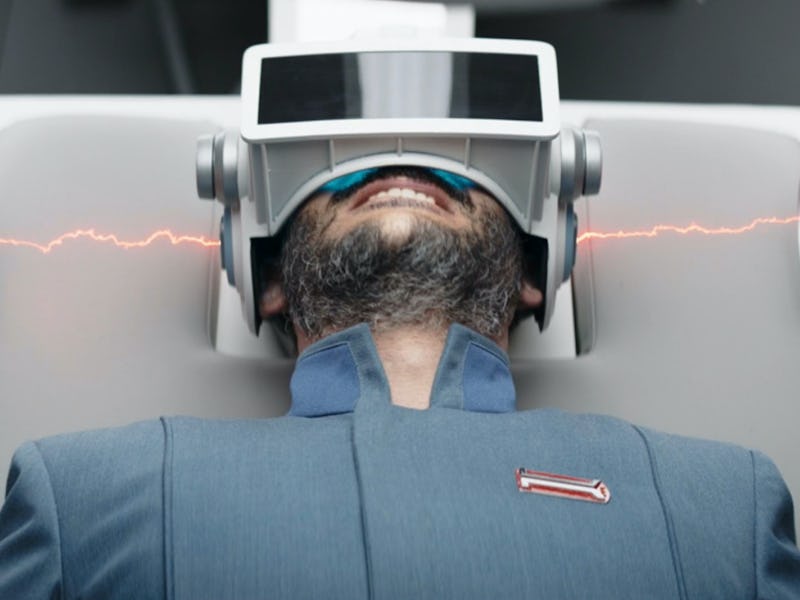The Mandalorian Just Solved a Star Wars Mystery the Sequels Ignored
Welcome to the New Republic, same as the old.

In its third episode, The Mandalorian Season 3 shifts its focus away from Bo-Katan (Katee Sackhoff) and Din Djarin (Pedro Pascal) in order to spend time with Dr. Pershing (Omid Abtahi) and Elia Kane (Katy M. O'Brian), two minor figures from the Disney+ series’ previous seasons. Former members of Moff Gideon’s now-disbanded Imperial Remnant unit, Dr. Pershing and Elia Kane give The Mandalorian a chance to explore what life is really like under the rule of the New Republic.
Unfortunately, the New Republic isn’t doing a very good job of cleaning up the Empire’s various messes. Indeed, while the galaxy’s new government has created a program dedicated to rehabilitating former Imperials and reintegrating them back into society, it’s revealed in The Mandalorian’s latest episode, titled “The Convert,” that said program also comes with some truly barbaric methods of dealing with its rule-breakers.
“The Convert” is, in other words, arguably the most politically-minded installment of The Mandalorian to date. In fact, while the episode doesn’t ever go quite as far with its political metaphors as, say, Andor did, “The Convert” does steal one powerful trick from that Tony Gilroy-helmed Rogue One prequel series.
Something’s Rotten in Coruscant
Dr. Pershing receives a harsh lesson in the rules of New Republic life in “The Convert.”
One of the most refreshing things about Andor was how it managed to feel simultaneously like a well-told Star Wars story and a stirring reminder of the dangers of fascism and oppression. In a time when fascism is on the rise again in so many parts of the world, Andor’s first 10 episodes seemed to carry extra weight with many of the show’s viewers. However, if you read or listened to any interviews with Andor’s creator, Tony Gilroy, you’d know that he didn’t necessarily intend to make the series socially relevant.
Instead, Gilroy focused more on pulling from real-world periods of tyranny and revolution in order to make Andor’s story feel more authentic. When he was working on Andor, Gilroy, by his own admission, based a lot of what happened throughout the show on real-life revolutionary moments. “The great thing about this show is … I could take something from the Haitian revolution, I could take something from here, [and] from the Russian revolution,” the showrunner said in one interview. “That’s the beauty of it.”
In “The Convert,” co-writers Jon Favreau and Noah Kloor bring a very similar approach to The Mandalorian’s depiction of the New Republic. Over the course of its runtime, the episode makes allusions to several real-world historical events, periods, and places.
In “The Convert,” the New Republic reveals that it prefers to fight fascism with... fascism.
The New Republic’s willingness to employ and work with an Imperial scientist like Dr. Pershing, for instance, feels undeniably similar to Operation Paperclip. That real-life secret intelligence program saw the United States bring over 1,000 German scientists from Nazi Germany after World War II and give them government jobs. The political and moral instability of the New Republic’s rule, meanwhile, makes The Mandalorian’s current post-Empire setting feel like the Star Wars equivalent of Germany’s Weimar Republic after World War I.
That period was characterized by its numerous problems, including the hyperinflation, global isolationism, and poor international standing that made life incredibly hard for the nation’s citizens. Streaks of political extremism and dueling forces of power throughout the Weimar Republic’s early years only made Germany’s already fragile sense of peace feel all the more unstable, too. With all this in mind, it’s hard not to look at all the chaos caused by the Imperial Remnant, as well as the Coruscant elite’s clear disinterest in the affairs of the New Republic, in a terrifying new light.
The harsh treatment of Germany in the wake of World War I by the world’s superpowers, additionally, feels undeniably similar to the way that the New Republic seems to treat any former Imperial citizens who act out of line, as Dr. Pershing does in the second half of “The Convert.” The New Republic’s openness to using Imperial torture technology also makes the galactic government feel all the more, well, fascistic.
What are the odds that some or all of these former Imperials went on to become soldiers for the First Order?
The Inverse Analysis — The Mandalorian’s allusions to real-world history make the Coruscant chapter of “The Convert” hit even harder than it might have otherwise. The series’ exploration of the New Republic’s unsteady hold over the galaxy also, notably, makes it even easier to understand how a fascistic organization like the First Order could have risen up in the wake of the Empire’s defeat.
There are, of course, still plenty of things about Star Wars’ Sequel Trilogy that don’t make much sense, but the formation of the First Order doesn’t feel like one of them anymore. In fact, The Mandalorian’s various unspoken references to post-WW1 Germany only make the Nazi-esque style of the First Order’s rally in The Force Awakens seem even more horrifyingly fitting.
New episodes of The Mandalorian premiere Wednesdays on Disney+.
INVERSE may receive a portion of sales if you subscribe to Disney+ through the link in this article.
This article was originally published on